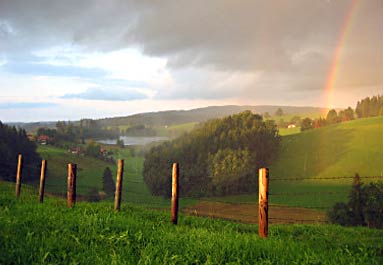This original column is provided free for one-time use with author credit at the end. It may be used for background with author credit. Copyright applies.
#136 FOR IMMEDIATE RELEASE: May 13, 2010
Reunions continue conversations and might start others
By Curtis Seltzer
BLUE GRASS, Va.—Life may be like high school, but, thankfully, reunions are designed to be better, and usually are.
The Class of 1963 turned 65 in 2010, and my Peabody High School classmates are gathering in Pittsburgh 47 years later.
Many of us ended up as fairly predictable extensions of our talents, taste for work and upbringing. But we had a few surprises—some good, some not.
I’m one of the few -- maybe, the only one -- who washed up in the American outback. I think I was drawn to the foot of Snowy Mountain by the absence of cocktail parties, at which I’m truly bad. My chit is dreadful, and my chat is worse.
I wasn’t born to the manure spreader, though impartial observers disagree on this point. Pittsburgh’s East End was not a seedbed for Future Farmers of America.
The closest I got to a cow during high school was the dreary Eat’n Park on Washington Boulevard where I once threw a Big Boy double burger at a girl who is now a high-ranking career public servant in Connecticut. It took a long time after I got home to clean that mayonnaise-based special sauce off the seat of my mother’s ’55 Chevy.
Boys in high school are creatures of testosterone combined with an immature prefrontal cortex, the part of our brain that exercises control over impulses and weighs consequences. In males, the prefrontal cortex shapes up in our mid-20s. Testosterone was our gas pedal while the prefrontal cortex was an unreliable handbrake. This, I hope, explains my Big Boy episode, among many others.
About 10 percent of my class has died…and they’re not likely to attend. We’ll put them on our shoulders as 17-year-olds.
We lost one in Vietnam, 21. Another -- who lived a block away -- came home disabled. And a short, quiet guy was killed in a drug raid, going through a door as a DEA agent. We’ve lost our scariest guy and the one who went through Yale in three years.
I grieve each deduction and replay their memories.
We’ve also lost those who never came back to the four earlier reunions. I’m sure they had good reasons. My guess is that they don’t want to revisit who they were in high school or what high school was—the embarrassments, the pressure, the putdowns, the comeuppances, the large amount of institutional idiocy.
Every class has a small volunteer group that organizes reunions. They spend an enormous amount of time doing this for us. Without their work, it doesn’t happen. No amount of thanks is sufficient.
I feel an obligation to them and to myself to participate. Attendance is like keeping a pinch of sourdough starter going in the back of the refrigerator. It’s just better to stick with some things than to stop.
Reunions are as much about touching again who each of us once was as seeing who each of us has become. Re-grounding ourselves in that vulnerable moment can help us take the next steps forward.
Teenagers are works in progress, even those who seemed the coolest, the most completed. Whoever we are today was there back then if only in our own shadows.
My classmates know me differently than how my wife and daughter do—a good thing for all concerned. I’m still “Corky.” Which is the way it should be.
One time through high school is plenty. Reunions make it better than it was. I’m pleased that nostalgia helps out and doesn’t cost too much.
Peabody in the early 1960s was a large, urban school, what we call today, “diverse”—racially, religiously, ethnically and, to a lesser extent, economically. It drew from middle schools in very different neighborhoods. We were The Balkans writ small.
Though mixed together in homerooms, classes and hallways, we tended not to mix. We kept ourselves loosely segregated by tribal identifications. Our reunions still tend to group out this way.
I can’t explain my own failure to reach out more than I did. I’m troubled by the number of my classmates I’ve never spoken to.
These walls crumbled a bit by the end of junior year, for me at least. I talked to guys from other neighborhoods. Intramural basketball helped. When I was fouled hard and unfairly, the big scary guy with the 130 IQ who spent two hours before school unloading produce trucks knocked the offender on his teakettle. I had been defended, as a teammate, despite our differences. I was amazed. The scary guy and I hadn’t said a word to each other for more than two years. Then, we began talking and became friends.
To the extent our class came together, it was as seniors. We won city championships in football and basketball, did well in volleyball and staged “Brigadoon,” because we had the talent to carry off a Broadway musical. I think we saw ourselves as special. Those accomplishments knitted the blanket that still warms us.
And in June of 1963, we spilled into the ’60s, for better and worse.
The years have softened our edges. We can still be prickly with each other, but it comes from habit. It’s not intentional, at least when I do it. We have all taken punches over the decades with parents, kids, divorces, money or bad habits. No one has escaped, even the most fortunate. We’re kinder to each other now, because all of us get up each morning with scars.
Certain things that were never said years ago, never will be. I was kissed seriously on the mouth at the last reunion by a happily married woman who I’ve known since grade school. She meant something historical by it…which is how I took it.
Classmates don’t love each other, but as veterans of a shared battle, we now hope for each other’s best. The competitiveness that is high school seems gone. Who has more money doesn’t seem to matter, but maybe I’m dense.
If there’s competition among us now, it’s about who has the fewest pounds to lose and who has to take the fewest pills. My place in our pantheon is secure: I beat everyone on baldness.
Although many of us did not like each other in high school, I’ve never heard anyone over the years hope for a classmate’s bad fortune. We’re saddened by the stories of going to jail, getting wiped out and wrestling with demons. I’ve heard no jealousy of success. I have, however, thought that some played life too safe, a posture common to kids who grew up on the financial edge.
If the music isn’t too loud, we will catch up with those we know. And I will talk to those I skipped over when I had more of a chance. And I hope that I will wince less in the middle of the night at something mean I said 50 years ago, or something I should have done and didn’t. If I could take back that Big Boy, I would.
Unlike our other reunions, this one feels like a goodbye. Maybe, we’ll do a 60th or one in our 75th year. Eventually, time will stop us, and no one will remember.
But until then, we’ll have one more go with each other. One more look, one last dance.
“From our Alma Mater, Maroon and Grey.”
With colors as awful as those, it’s a lot easier to be true to my class than to be true to my school.
Curtis Seltzer is a land consultant who works with buyers and helps sellers with marketing plans. He is author of How To Be a DIRT-SMART Buyer of Country Property at www.curtis-seltzer.com where his weekly columns are posted. He also writes for www.landthink.com.
Contact: Curtis Seltzer, Ph.D.
Land Consultant
1467 Wimer Mountain Road
Blue Grass, VA 24413-2307
540-474-3297
curtisseltzer@htcnet.org
www.curtis-seltzer.com
This original column is provided free for one-time use with author credit at the end. It may be used for background with author credit. Copyright applies.
|









